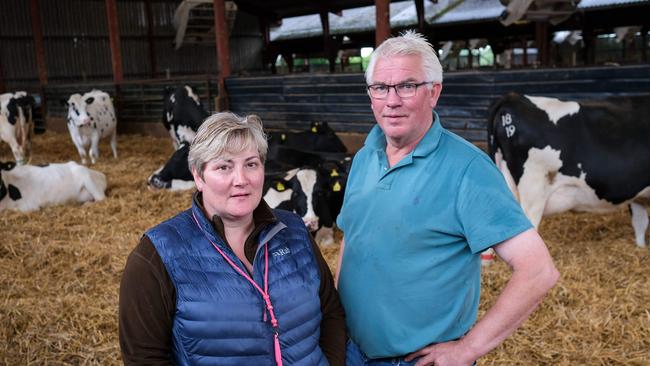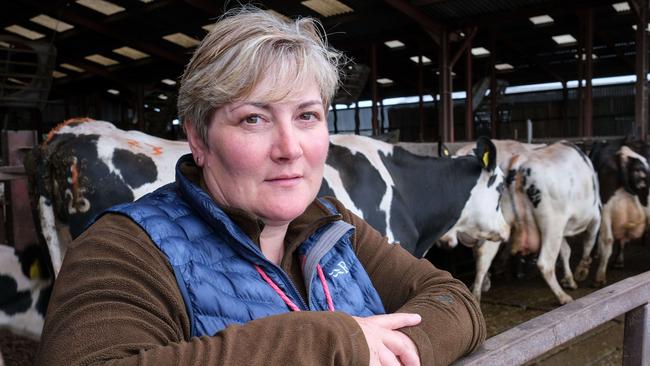British farmers’ foot and mouth warning to Australia: ‘Go hard, go fast’
Farmer Moira Fisher has an urgent message for Australian politicians regarding a possible foot and mouth outbreak: Act now, and overreact.

Farmer Moira Fisher has an urgent message for Australian politicians dealing with the fear that the Indonesian foot and mouth outbreak could be introduced to Australia: Act now, and overreact.
Ms Fisher, along with her husband, Robin, on Smalmstown Farm, Longtown, lost their entire livestock herds in the 2001 foot and mouth crisis in Britain.
“Australia has to overreact initially,’’ she warned. “If it is then not as bad, you can pull things back, but don’t let it get away from you. You can’t let it into your country. Australia is so vast and if it gets in to any one cloven-footed animal, even the wildlife, it can spread it.’’
Mr Fisher was milking cows on his farm in Longtown, just outside Carlisle on the English border with Scotland, with a herdsman in late February 2001 when they noticed several cows had blisters on their udders. “I went into shock,” recalled Mr Fisher, now 59.
Foot and mouth had been detected days earlier some 80km away on a pig farm in Northumberland – believed to have come from contaminated restaurant scraps from food sourced from South Africa that were fed to the pigs – and Mr Fisher immediately understood the consequences of what he was looking at.
He knew he would lose his entire livelihood. “I was just trying to comprehend the magnitude of what was about to happen,’’ he told The Australian.
His was the first of what would be 893 farms with confirmed infected cases, and a further 1934 farms having complete or partial culls of livestock just in Cumbria. More than a million sheep, 200,000 cattle and 40,000 pigs, thousands of goats and deer in just this one county were culled.
Within six months, as many as 10 million animals across Britain on 10,000 farms had been killed before the disease was brought under control.
On that February day when Mr Fisher’s worst fears were realised, he called the vet and the farm was put into immediate quarantine. The children couldn’t go to school and no one was allowed on to the farm except men in biological suits who arrived to take blood samples.
Inside the farmhouse, young sons Scott, 5, and Tom, 7, saw their father cry for the first time.
Such was the speed of the infection that some of the cows that were calving lost their young. The herd suffered dreadfully with the blisters and some gangrene.
Within two days, the disease was confirmed by laboratory analysis. The auctioneer arrived to value the stock and then the slaughter team arrived: 300 cows were taken into the sheds thinking they were to be milked and were instead shot dead.
Another 400 cattle and 5500 sheep were also killed.

“It took all weekend,’’ said Ms Fisher. “It was tremendously traumatic. It was also the lambing and calving season so it was particularly difficult. My brother’s sheep were being put on a wagon (for slaughter) and the ewes were lambing. A lot of people had very grim stories.’’
What made the situation even worse were the huge pyres of burning livestock carcasses spewing blackened smoke that enveloped the countryside with a dank smell of death for months.
“It was horrendous – sometimes we would have the smoke enter the house through our chimneys,” said Mr Fisher.
On Radio Cumbria each morning, the announcer would grimly announce the identification or holding numbers of farms with confirmed cases, and each day scores of farms, most of them small family holdings, would be added to the list.
Some farmers, including one friend of the Fishers, would commit suicide, unable to cope.
As the crisis spread, the army was called in to handle the logistics of the culls, which were extended to farms within several kilometres of a confirmed case even if their herds were healthy. Farmers who had for months been carefully quarantining their stock in strict lockdown conditions were devastated when government officials knocked on the door.
A government inquiry conducted by UK chief veterinary officer Jim Scudamore found that the source of the infection was a single case of infected meat consumed by pigs on Burnside Farm in Northumberland. It had spread when infected sheep from a neighbouring farm to Burnside were taken to Hexham and Longtown sheep auction markets.
One of the men who helped milk the Fishers’ cows had been working at the Longtown market yards down the road, where it was later suspected he may have handled the infected sheep and had brought the disease on to the farm.
“It was like dominoes falling,’’ said Ms Fisher.
Her husband added: “Australia has to understand that it spreads before you even know it is there. The incubation period is a week, so by the time the first one is seen, it has already spread. The biggest thing for us was that the UK didn’t stop movements of livestock immediately (upon detecting a suspected case). That couple of days deciding what to do meant it spread like wildfire.’’
The Scudamore report said the virus was already widely geographically disseminated by February 20 when the first outbreak was confirmed.
The impact of the outbreak on the agriculture and tourism industry was incalculable. Even today, farmers can’t move livestock within six days of having new animals brought on to a farm.
And the psychological distress lingers, 21 years on. “We didn’t restock for a year, we were very nervous, but mentally, well, I don’t know,’’ Mr Fisher said.






To join the conversation, please log in. Don't have an account? Register
Join the conversation, you are commenting as Logout